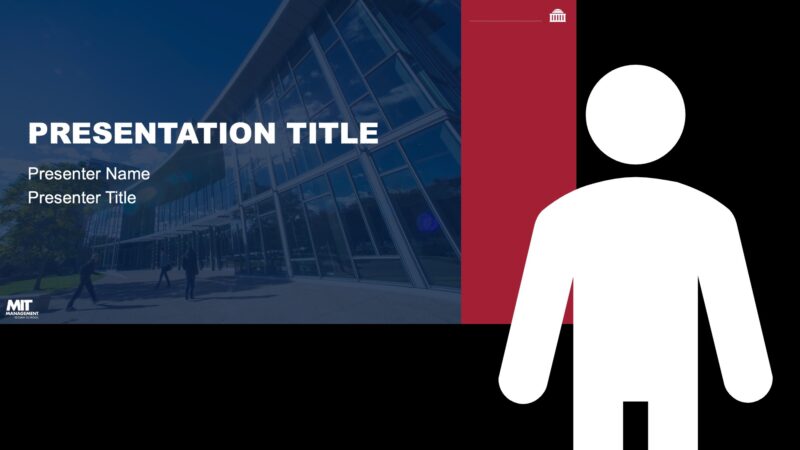Request a Consultation
To reserve the Teaching Studio, request a consultation with a member of the Teaching & Learning Technologies team. We’ll contact you to learn more and schedule your studio session.
- Submit your consultation request form at least ten business days before the studio session date.
- When you fill out the form, select Teaching Studio from the first dropdown menu.
- If this is your first time using the studio and it is available, we’ll confirm your booking after you complete the required studio orientation and (for some projects) a studio consultation.
- Some projects may be eligible for instructional design support including presentation design guidance and video script reviews.
- All Teaching Studio projects must be closely related to teaching and learning at MIT Sloan.
- Scheduling is based on both studio and staff availability, with priority given to teaching and learning projects on a first-come, first-served basis.
Request a Consultation
Create Your Slides
1. Download a Studio Slides Template
We designed these slide templates to adhere to Teaching Studio best practices and MIT Sloan brand guidelines. If you’re considering using a different design or format, please consult with our team for guidance.
Projector Scene Slides Template

In the Projector Scene, your slides appear in a window next to you. This setup looks like a classic presentation. We designed the Projector Scene Slides Template with an empty “buffer” space on the right 20% of most slides so you don’t have to worry about blocking any essential information during your presentation. Learn more about the studio scenes.
Download the Projector Scene Slides Template
Full Screen Scene Slides Template

In the Full Screen Scene, your slides fill the entire backdrop behind you. This setup looks more like a typical video with content appearing around and alongside you during your presentation. We designed the Full Screen Scene Slides Template with an empty “buffer” space on the right 40% of most slides so you don’t have to worry about blocking any essential information during your presentation. Learn more about the studio scenes.
Download the Full Screen Scene Slides Template
2. Customize Your Slides
Once you’ve downloaded the slide template of your choice, you can customize it to fit your content. While the design and layout need to adhere to MIT Sloan’s brand standards, there’s still room for personalization. Add images, text, and other visuals to make the slides uniquely yours.
Prioritize Visual Content
In Multimedia Learning, Richard Mayer’s research-based guide to multimedia instruction, the Multimedia Principle states that “People learn better from words and pictures than from words alone” (as quoted in Davis & Norman, 2016). How can you optimize your video for this principle?
- Include images to illustrate key points.
- Make sure all images enhance or clarify meaning rather than being purely decorative.
- Use simple graphs, charts, and infographics to convey complex ideas in a way that’s engaging and easy to understand.
Remember that visuals should always support and enhance your spoken words, not overshadow them.
Keep It Simple
Less is more when it comes to designing slides for studio presentations. As Mayer describes in Multimedia Learning, learners benefit most from streamlined content free of extraneous material (as cited in Davis & Norman, 2016). Aim for a minimalist design that helps your audience concentrate on the key takeaways.
- Use a clean layout with plenty of white space to highlight the essential points.
- Limit the text to key phrases or bullet points
- Use a large font size (at least 18pt) for easy readability.
- Where possible, make sure the text on your slide exactly mirrors what you say out loud. This helps your slides support rather than compete against your spoken presentation.
Design the Session
The Teaching Studio is a unique space where you can facilitate dynamic class sessions. When you teach live online in the studio, you can stand up, move around, and see your students on a big screen. Instructors have told us that teaching in the studio feels less like joining a Zoom call and more like leading an in-person class.
Consider dividing your agenda into a series of short activities. For example, you might include any of the following:
- Give a short (up to 10-minute) lecture to introduce new concepts and set the scene for activities.
- Create a think-pair-share activity by presenting a prompt to students and engaging them in these steps:
- Think through the prompt individually.
- Pair with a partner or small group in a breakout room to discuss the prompt.
- Share their findings or takeaways with the class (verbally, using a shared document, or in the Zoom chat).
- Facilitate a “fishbowl” discussion where a few students talk about a prompt in front of the class while others take notes, prepare to summarize the conversation, or generate follow-up questions.
- Invite students to participate in a Zoom poll or a Poll Everywhere activity. (Poll Everywhere activity types include multiple choice polls, Q&As, word clouds, and more.)





